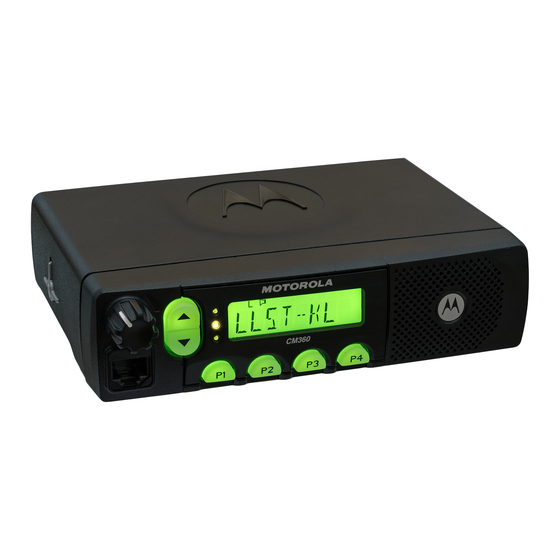Motorola CM340 Сервісна інформація - Сторінка 11
Переглянути онлайн або завантажити pdf Сервісна інформація для Радіо Motorola CM340. Motorola CM340 26 сторінок. Commercial series controlhead
Також для Motorola CM340: Посібник користувача (24 сторінок), Посібник користувача (5 сторінок), Посібник користувача (12 сторінок)

Controlhead Model for CM160 and CM360
3.3
Keypad Keys
The control head keypad is a four-key design. All keys are configured as two analog lines read by
µP. The voltage on the analog lines varies between 0V and 3.3 V depending on which key is
pressed. If no key is pressed, the voltage at both lines is 3.3V. The key configuration can be thought
of as a matrix where the two lines represent one row and one column. Each line is connected to a
resistive divider powered by 3.3V. If a button is pressed, it will connect one specific resistor of each
divider line to ground level and thereby reduce the voltages on the analog lines. The voltages of the
lines are A/D converted inside the µP (ports PE 6 - 7) and specify the pressed button. To determine
which key is pressed, the voltage of both lines must be considered.
The same analog lines also support a keypad microphone. A microphone key press is processed in
the same manner like a control head key press.
3.4
LCD Driver
The LCD (36 x 4 segemnts) is controlled by U3. It has an on onboard clock controlled by R28
(typically 20kHz measured on pin 2). U3 is operated from the 5V supply and is controlled over the
SPI bus (SPI_CLK J103-17, SPI_MOSI J103-16, LCD chip select J103-18). Chip select is active low.
U2 is used to provide level shifting between the 3.3V logic from the uP and the 5V required by U3.
3.5
Status LED's and Back Light Circuit
All indicator LEDs (red, yellow, and green) are driven by current sources. To change the LED status
the host radio sends a data message to the control head shift register via the SPI bus. The control
head shift register determines the LED status from the received data and switches the LEDs on or
off via Q8-Q10.
Backlighting for the LCD and keys is provided by a matrix of 21 LEDs arranged in 7 columns of 3
rows. The LEDs are driven from a constant current circuit (Q12, U1 and associated parts). There are
4 levels of baclight: off, low, medium and high, which are controlled by two outputs (pins 15, 1) from
the shift register (U8). The current is controlled by transistor Q12. The op amp U1 monitors the
current by measuring the voltage drop across R26, R27 and adjusting the bias of Q12 to achieve the
required level as set by the combined shift register o/ps. When in the off state, Q11 is also turned on
to clamp the base of Q12 so as to force it off. This ensures that the LEDs are fully off. Q11 is
controlled by pin 3 of the shift register U8.
3.6
Microphone Connector Signals
The MIC_PTT line (J102-3) is grounded when the PTT button on the microphone is pressed. When
released, this line is pulled to 9.3V by R33. Two transistor stages (Q14, Q13 and associated parts)
are used to level shift between 9.3V and 3.3V required for the uP while keeping the same sense
(active low for PTT pressed).
Two of the mic socket lines (J102-2, 7) have dual functions depending on which type of microphone
or SCI lead that is connected. An electronic switch (U41) is used to switch these two lines between
mic keypad operation or SCI operation. The switch (mux) is controlled by the uP through J103-20
with level shifting (and inversion) provided by transistor Q41. When MUX_CTRL (103-20) is low the
electronic switch is in the mic keypad mode. The mic socket (J102) pin 2 is connected to the keypad
row line that goes to J103-13 and pin 7 is connected to the keypad column line that goes to 103-12.
When MUX_CTRL (103-20) is high the electronic switch is in the SCI mode. The mic socket (J102
pin 2) is connected to the SCI line that goes to J103-4 and pin 7 is connected to the BOOT_RES line
that goes to J103-11.
2-5
